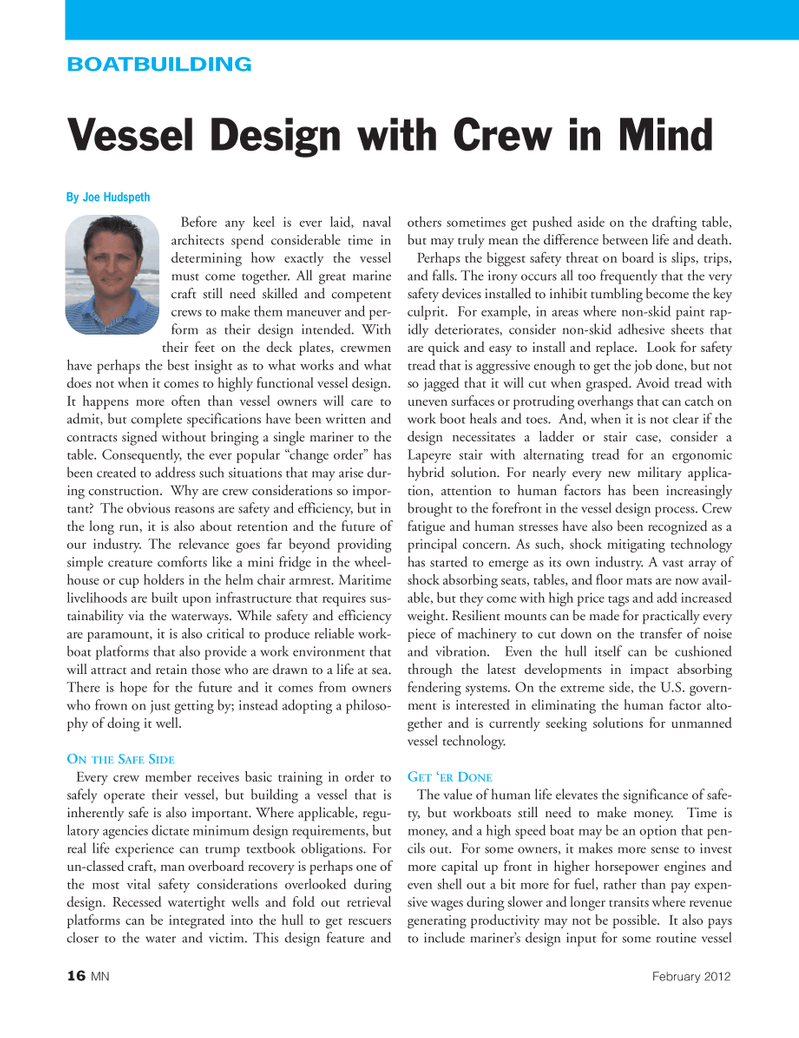
Page 16: of Marine News Magazine (February 2012)
Inland Bulk Transportation
Read this page in Pdf, Flash or Html5 edition of February 2012 Marine News Magazine
16MNFebruary 2012 BOATBUILDING Before any keel is ever laid, naval architects spend considerable time in determining how exactly the vessel must come together. All great marine craft still need skilled and competentcrews to make them maneuver and per- form as their design intended. With their feet on the deck plates, crewmen have perhaps the best insight as to what works and what does not when it comes to highly functional vessel design. It happens more often than vessel owners will care to admit, but complete specifications have been written and contracts signed without bringing a single mariner to thetable. Consequently, the ever popular ?change order? has been created to address such situations that may arise dur- ing construction. Why are crew considerations so impor- tant? The obvious reasons are safety and efficiency, but in the long run, it is also about retention and the future of our industry. The relevance goes far beyond providing simple creature comforts like a mini fridge in the wheel- house or cup holders in the helm chair armrest. Maritime livelihoods are built upon infrastructure that requires sus- tainability via the waterways. While safety and efficiency are paramount, it is also critical to produce reliable work- boat platforms that also provide a work environment that will attract and retain those who are drawn to a life at sea. There is hope for the future and it comes from owners who frown on just getting by; instead adopting a philoso- phy of doing it well. ONTHE SAFESIDEEvery crew member receives basic training in order to safely operate their vessel, but building a vessel that is inherently safe is also important. Where applicable, regu- latory agencies dictate minimum design requirements, but real life experience can trump textbook obligations. For un-classed craft, man overboard recovery is perhaps one of the most vital safety considerations overlooked during design. Recessed watertight wells and fold out retrieval platforms can be integrated into the hull to get rescuers closer to the water and victim. This design feature and others sometimes get pushed aside on the drafting table,but may truly mean the difference between life and death. Perhaps the biggest safety threat on board is slips, trips, and falls. The irony occurs all too frequently that the very safety devices installed to inhibit tumbling become the keyculprit. For example, in areas where non-skid paint rap- idly deteriorates, consider non-skid adhesive sheets that are quick and easy to install and replace. Look for safety tread that is aggressive enough to get the job done, but not so jagged that it will cut when grasped. Avoid tread with uneven surfaces or protruding overhangs that can catch on work boot heals and toes. And, when it is not clear if the design necessitates a ladder or stair case, consider aLapeyre stair with alternating tread for an ergonomic hybrid solution. For nearly every new military applica- tion, attention to human factors has been increasingly brought to the forefront in the vessel design process. Crew fatigue and human stresses have also been recognized as a principal concern. As such, shock mitigating technologyhas started to emerge as its own industry. A vast array of shock absorbing seats, tables, and floor mats are now avail- able, but they come with high price tags and add increased weight. Resilient mounts can be made for practically every piece of machinery to cut down on the transfer of noise and vibration. Even the hull itself can be cushioned through the latest developments in impact absorbing fendering systems. On the extreme side, the U.S. govern- ment is interested in eliminating the human factor alto- gether and is currently seeking solutions for unmanned vessel technology. GET?ERDONEThe value of human life elevates the significance of safe- ty, but workboats still need to make money. Time is money, and a high speed boat may be an option that pen- cils out. For some owners, it makes more sense to invest more capital up front in higher horsepower engines and even shell out a bit more for fuel, rather than pay expen- sive wages during slower and longer transits where revenue generating productivity may not be possible. It also pays to include mariner?s design input for some routine vessel By Joe HudspethVessel Design with Crew in Mind MN#2 (1-17):MN 2011 Layouts 2/3/2012 12:04 PM Page 16

 15
15

 17
17
